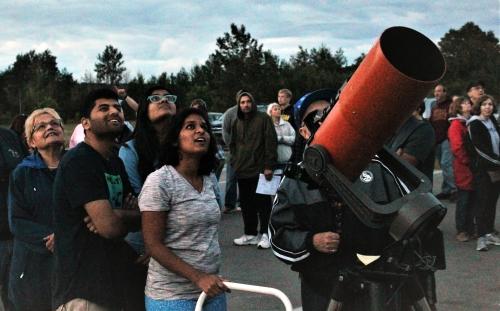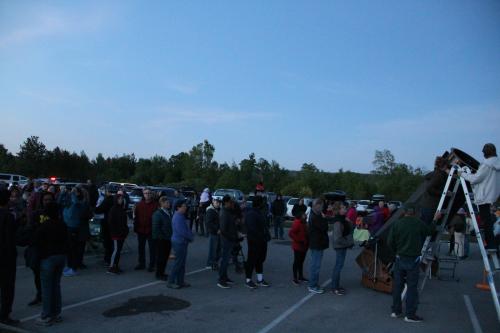Looking out at the stars high atop a dune at Sleeping Bear Dunes National Lakeshore is a special experience - one that is new for many city folks.
The National Lakeshore encourages people to get out and look up at Star Parties held throughout the summer.
“It’s always one of my favorite things we do,” says Dave Fenlon, Education Lead/Interpretive Park Ranger at Sleeping Bear Dunes National Lakeshore. “I have a deeper appreciation for the night sky. It can be a pretty powerful experience.”
Fenlon recalls walking the dunes one evening when he overheard a woman crying. Fenlon stopped to ask if everything was okay, and she said her tears were tears of joy.
“She had never spent a night away from the city,” Fenlon says. “She had no idea there were that many stars.”
Star Parties showcase night sky
Sleeping Bear Dunes National Lakeshore’s popular Star Parties and Solar Viewing events return this summer, and they get better as the sun sets earlier and the Milky Way becomes more visible.
Star Parties are one of the National Lakeshore’s most popular programs, often drawing up to 500 people over the course of the night. The parties take place 9-11 p.m. on select Saturdays at the Dune Climb parking lot. Astronomers from Grand Traverse Astronomical Society bring out their telescopes for the event.
-
Saturday, July 13
-
Saturday, August 10* Viewing party will be at the Thoreson farm during the Port Oneida Fair.
-
Saturday, August 31
-
Saturday, September 14
All sky programs offered by the National Lakeshore are free. Participants need only purchase the park entrance pass or have an annual pass displayed in their vehicle to join in the fun.
In addition, a Solar Viewing is scheduled 3-6 p.m. July 27 at the Dune Climb. This event will feature family-friendly ranger-led activities related to the Sun and our solar system. Special solar viewing scopes will also be on-hand, courtesy of GTAS, that allow for safe viewing of our closest star, the Sun.
Enjoy education, telescopes
During the viewing parties, park visitors can interact with park rangers and astronomers from the Grand Traverse Astronomical Society (GTAS) and learn about the night sky. Rangers provide information on preserving dark skies or tell stories about constellations and then let GTAS members discuss what is visible on that particular evening.
Volunteers from the astronomical society set up telescopes for attendees to examine the Moon, visible planets, and various constellations. The telescopes allow visitors to see prominent craters and other details on the moon, as well as various star clusters, nebulas, and constellations of the Milky Way.
“Into August and September is when we can see the Milky Way and get the moon out of the way,” says Bob Moler, a founding member of Grand Traverse Astronomical Society.
The moon phases play a role in what people can see. The clouds do too. If it turns out to be cloudy, the park rangers usually cancel the program two hours in advance. People can call 231-326-4700, ext. 5005, and listen to the voicemail recording with the decision.
If the moon is full and bright, it’s hard to see much besides the moon, Moler says, describing it as a big streetlight in the sky. The night sky viewing gets better as it gets darker, and some volunteers stay past 11 p.m. if people are interested.
“We stay until everyone is satisfied and wants to go home,” Moler says. “Sometimes that’s midnight or after if there’s lots of stuff to see.”
Star Parties draw crowds
 The Star Parties began around 2010 and continue to be popular with visitors. People can show up when they want and stay as long as they want or come early to climb dunes and watch the sunset. Many park visitors happen upon the Star Parties by accident.
The Star Parties began around 2010 and continue to be popular with visitors. People can show up when they want and stay as long as they want or come early to climb dunes and watch the sunset. Many park visitors happen upon the Star Parties by accident.
“It’s one of the most popular things we do,” Fenlon says. “There are some real passionate amateur astronomers out there. We are mainly on hand to provide information about dark skies, and the importance of dark skies.”
The evening includes activities for kids and information about nocturnal animal adaptations. Park rangers share constellation stories and oral traditions.
“I have been trying to steer things toward an Anishinaabe perspective,” Fenlon says. “We tell the story about the Great Fisher and how it overlaps with Ursa Major and the Big Dipper.”
Sleeping Bear Dunes has some of the darkest night skies around, and it’s a fun evening whether you are local or on vacation.
“People love the night sky,” Fenlon says. “We’re not immune to the light pollution, but we still have some pretty good dark skies. The stars are going to pop a little more, and people are more likely to see deep space objects.”
Free and educational family fun
 The parties are also educational in that GTAS members are experienced astronomers who know what to look for through the telescopes. “We have those experts on hand, and they provide a lot of context and have a wealth of knowledge to share,” Fenlon says.
The parties are also educational in that GTAS members are experienced astronomers who know what to look for through the telescopes. “We have those experts on hand, and they provide a lot of context and have a wealth of knowledge to share,” Fenlon says.
Moler has been interested in stars and space for most of his life and worked at the planetarium in Grand Rapids. He enjoys sharing his knowledge with others. They also point out satellites and other space activity.
“There’s a lot of education that people learn by looking at the moon through the telescope,” he says. “You can see craters and mountains. It’s a cool thing to look at.”
The GTAS has a large 25-inch telescope, which takes two or three people to set up, that attracts a really big crowd. “People stand in line to look through it,” Moler says. “They want to look through the big one.”
GTAS volunteers try to plan the parties around the moon phases, so people can see the constellations and the Milky Way spanning the sky, which is cool for the city folks, Moler says.
“The constellations, they’re always there but you need the moon out of the way,” Moler adds. “The moon just lights up the sky.”
The telescopes are set up in the Dune Climb parking lot so they are on a stable base, but “we encourage people to hike up on the Dune Climb to get away from it all,” Fenlon says.
Even if people can’t get to a Star Party, visitors can venture out on their own to explore. Sleeping Bear Dunes offers great dark skies throughout the year, including viewing of the Northern Lights, Meteor Showers, and the Milky Way.
“We’re a 24-hour park, so I try to stress to people that they are welcome to stay longer,” Fenlon says. “You are not supposed to camp or sleep out there, but you could potentially come out in the middle of the night. There is no closed time.”
Dark sky park designation
Sleeping Bear Dunes National Lakeshore is in the process of becoming a certified International Dark Sky Park, joining parks out west including Canyonlands National Park in Utah and Great Basin National Park in Nevada.
“We’re a year or two out,” Fenlon says. “We are in phase two of three, and if and when that does go through, we would be the only official certified dark sky (national) park east of the Mississippi River.”
Starry night skies and natural darkness are important components of the special places the NPS protects. National parks hold some of the last remaining harbors of darkness and allow the public to experience this endangered resource.
The designation would increase dark sky tourism and “be a pretty cool feather in our cap,” Fenlon says.
Headlands International Dark Sky Park, a 550-acre parcel west of Mackinaw City at the tip of the Mitten, became one of the first 10 places in the world to earn the prestigious International Dark Sky Park designation.
But Headlands, which is operated by Emmet County, is more remote for people coming from down state or larger cities such as Detroit or Chicago, Fenlon says.
Tips if you attend
When arriving at the Dune Climb for a Star Party, guests should park in the row furthest from the dunes with headlights facing M-109. Volunteers will be assisting with parking. You also need a National Lakeshore pass or annual pass.
Be sure to stop by the National Lakeshore’s Bear Force One van in front of the Dune Climb for more information and handouts. Rangers recommend bringing a flashlight (with a redlight setting or filter to prevent disrupting night vision, if possible) for the walk back to your car and bug spray.
Moler says to dress for the weather and bring a jacket or sweatshirt. Sometimes the evenings turn cool after dark.
In addition, you can bring your own binoculars, beach chairs, and blankets for a more comfortable experience, and water is always recommended for National Park Service (NPS) programs.
Visit GTAS observatory
The Grand Traverse Astronomical Society is a nonprofit organization dedicated to education and enjoyment of the night sky. Established in 1982, the GTAS has about 30 members from the Traverse City and the Grand Traverse area of northern Michigan.
Meetings are held on the first Friday of every month beginning at 8 p.m. at Northwestern Michigan College's Joseph H. Rogers Observatory, 1753 Birmley Rd, Traverse City
The GTAS welcomes guests at the observatory and its monthly meetings. For more information about the GTAS, go to http://www.gtastro.org/.
For more Sleeping Bear Dunes programs, visit the calendar as you plan your trip.
Marla R. Miller is a freelance travel writer, content writer, and journalist. Visit her website at marlarmiller.com.